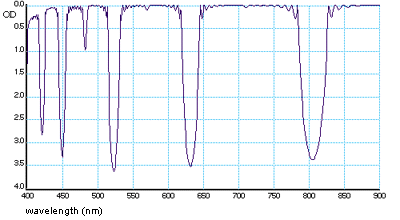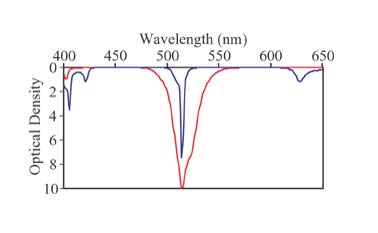|
Home Page | Products | Contact Us | News & Events | Request Info. |
||||
|
|
Optical Filters for All Occasions |
|
||
|
|
||||
|
|
Rejection Band & Baffle Notch FiltersThese filters block a narrow spectral band, such as the monochromatic light from a laser, while transmitting other wavelengths. Rejection Band (RB) filters block more than 99.9% of light in a 15 to 40nm bandwidth. The average transmission outside the stopband is 75% except in those spectral regions where higher and lower harmonics cause relatively high reflection. Specially designed rejection band filters reflect more than one spectral band, or perform at off-normal angles of incidence.
This is a 632.8RB filter. Bandwidth of principle rejection is about 25nm at 10% transmission (OD1). Rejection regions recur at harmonic wavelengths both longer and shorter than the principle rejection band
Baffle Notch (BN) filters consist of four laser-aligned interference filters in a Chevron baffle configuration sealed in a rectangular housing. These filters are designed to provide a band of deep attenuation (greater than OD 5) with high throughput on both sides of the rejection band. The width of the rejection band, measured at 10% transmission, may be as narrow as 6nm or as wide as 100nm. Baffle notch filters are useful in applications where highly efficient elimination of an interfering optical line or band is necessary and there is sufficient room in the optical system for the Chevron baffle configuration. Best performance is achieved with a well-collimated incident light beam, although these filters may be used with halfcone angles up to approximately 20 degrees, depending on the width of the rejection band.
Theoretical spectral traces of two 514.5BN baffle filters, having bandwidths of 10 and 50nm at 10% transmission (OD 1).
|
|
Back to top | Home Page | Products | Contact Us | News & Events | Request Info. |
|
|
|
|
|
|
|
|
Copyright © 2007 Glen Spectra All rights reserved |
|



